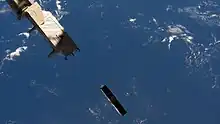
The Scintillation Prediction Observations Research Task Mission (SPORT) is a partnership between several Brazilian and North American institutions whose objective is to place a small satellite into orbit dedicated to the study of the equatorial ionosphere.[1][2][3] In Brazil, the project has institutional support from AEB, ITA and INPE. SPORT has received financial support from FAPESP via thematic project (nº 16/24970-7), valid from December 1, 2017, to November 30, 2022.[4] In the USA side, the participating institutions are NASA, United States Air Force, Utah State University, University of Texas at Dallas, University of Alabama at Huntsville and the Aerospace Corporation. The satellite was launched on November 26, 2022, from the Kennedy Space Center in Florida, USA, and placed into orbit from the International Space Station (ISS) on December 29, 2022.[5] Until April, the satellite carried out the commissioning stage to stabilize the satellite in its low orbit around the Earth.[6] The satellite began carrying out science measurements from May 2023, with the detection of plasma bubbles having been publicly announced.[7] The re-entry of the SPORT satellite into the atmosphere was scheduled for early October 2023.[7]
References
- ↑ Spann, James. "The Scintillation Prediction Observations Research Task (SPORT):An International Science Mission using a CubeSat" (PDF). 31st Annual AIAA/USU Conference on Small Satellites. Retrieved 24 November 2023.
- ↑ "SPORT (Scintillation Prediction Observations Research Task)". eoPortal. Retrieved 24 November 2023.
- ↑ "SPORT". Gunter's Space Page. Retrieved 24 November 2023.
- ↑ "Programa de Pesquisa de Observação e Previsão da Cintilação (SPORT)". FAPESP. Retrieved 16 May 2023.
- ↑ "SPORT and petitSat CubeSats to Shed Light on Space Weather Disturbances". National Aeronautics and Space Administration. 30 December 2022. Retrieved 16 May 2023.
- ↑ "SPORT Satellite Commissioning Update". National Aeronautics and Space Administration. 30 March 2023. Retrieved 16 May 2023.
- 1 2 "SPORT Satellite First Light: Observations of Plasma Bubbles". National Aeronautics and Space Administration. 30 August 2023. Retrieved 5 September 2023.